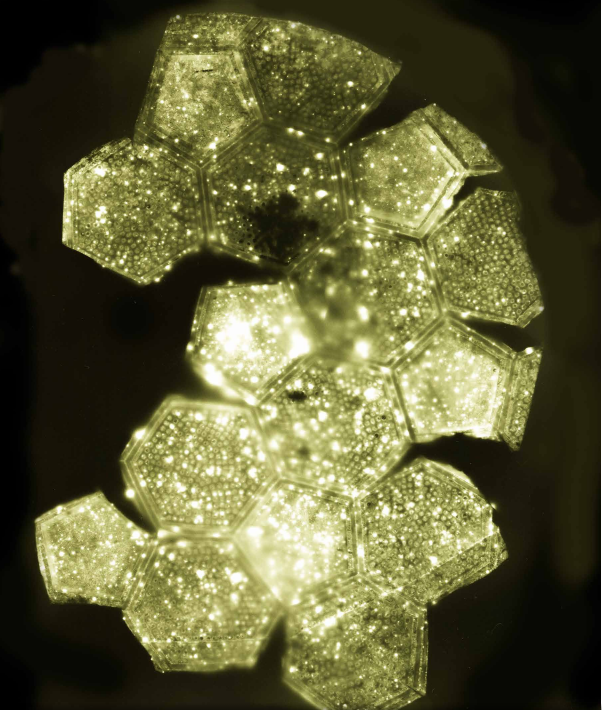Although the 2011 Fukushima Daiichi nuclear power plant disaster occurred on the other side of the world, photographer Morizumi Takashi is bringing the fallout close to home.
An ethereal beauty spills out from Takashi’s photographs of radiation-poisoned objects, but hidden beneath the visual allure is a bitter narrative of a radioactive disaster transcending national boundaries.
Takashi’s collection, titled “Strange Beauty: Autoradiography from Fukushima,” will open at 4 p.m. tonight in the University Art Gallery at the Frick Fine Arts Building. Local volunteer organization Remembering Hiroshima, Imagining Peace will put on an opening reception at 5 p.m. and informational panel on nuclear power’s potential danger from 6 to 7:30 p.m.
The exhibit runs until Friday, March 18.
Remembering Hiroshima, Imagining Peace collaborated with Pitt’s East Asian Studies Department to sponsor the event and artist’s exhibit. The photographer has worked in the exclusion zone of the Fukushima Daiichi nuclear power plant since 2011 after the earthquake in Japan precipitated a nuclear meltdown.
“Art is a very good way of raising consciousness, and we chose these particular photographs because they are so compelling, and hopefully they will cause people to think about what happened and what we are going to do in this country,” said Robin Alexander, a member of the coordinating committee for RHIP.
At first glance, “Strange Beauty’s” glittery compositions portray seemingly mundane objects, arbitrarily depicting the life of common people in the Fukushima Prefecture, which occupied the power plant before the Tsunami in Japan. But the people are anything but banal, and the objects are certainly not meaningless.
“The glittering spots in the photos show radiation emitted by fine particles of a radioactive substance called cesium clinging to the surface of objects,” said Takashi in the exhibit’s artist statement. “Film placed over those objects was exposed by the radiation, causing the sparkling appearance.”
Takashi uses this method, called autoradiography, to expose the radiation’s intangible effects that silently plague the region.
The exhibit will also feature a second component of Takashi’s work, titled “Downwinders,” which depicts photographs of the people who still live in the region, tied down by a lack of resources. One photograph captures a desultory elderly couple walking with face masks, while another shows decaying cow corpses on an abandoned dairy farm.
Following Tuesday’s opening reception, RHIP will host a panel titled “Perspectives on Nuclear Power Past and Future” to discuss the exhibit’s socioeconomic and political relevance to the people still living near the plant.
The panelists will include Morizumi, who will Skype in from the Fukushima site; Patricia DeMarco, former executive director of the Rachel Carson Homestead Association and director of the Rachel Carson Institute at Chatham University; as well as Zeba Ahmed, a 2014 Pitt graduate who received a Fulbright research grant to study in Japan.
DeMarco received her Ph.D. in biology at Pitt and has been a prominent voice in environmental issues in Pittsburgh. In the panel she will speak about inadequacy and dangers associated with nuclear power and the long-term effects since nuclear weapons’ open-air testing began in the 1950s.
Ahmed majored in Japanese and sociology at Pitt and received the Fulbright research grant to conduct research on nonprofit groups in Japan. Studying near the disaster area, she saw the disaster’s desolation firsthand.
“It was like a ghost town because everything that is there was left from four years ago, except there are no people because of the radiation,” Ahmed said. “It was a very powerful experience.”
Nuclear energy is a hotly contested and controversial topic because of its health and environmental concerns. RHIP will examine nuclear energy’s negative effects in the panel, which will discuss the consequences of human exposure to radiation specifically, in addition to other practical issues with nuclear power as an energy source.
“The reality is that the disaster in Fukushima is still with us,” Alexander said. “Contaminated water continues to flow into the ocean and reach our west coast.”
If Takashi’s compositions don’t express the artist’s opinion on nuclear energy outright, he also spelled it out for his audience in a note to accompany the photographs in the exhibit.
“I am hopeful that these images will help to change the path of spaceship earth as it hurtles toward catastrophe.”



